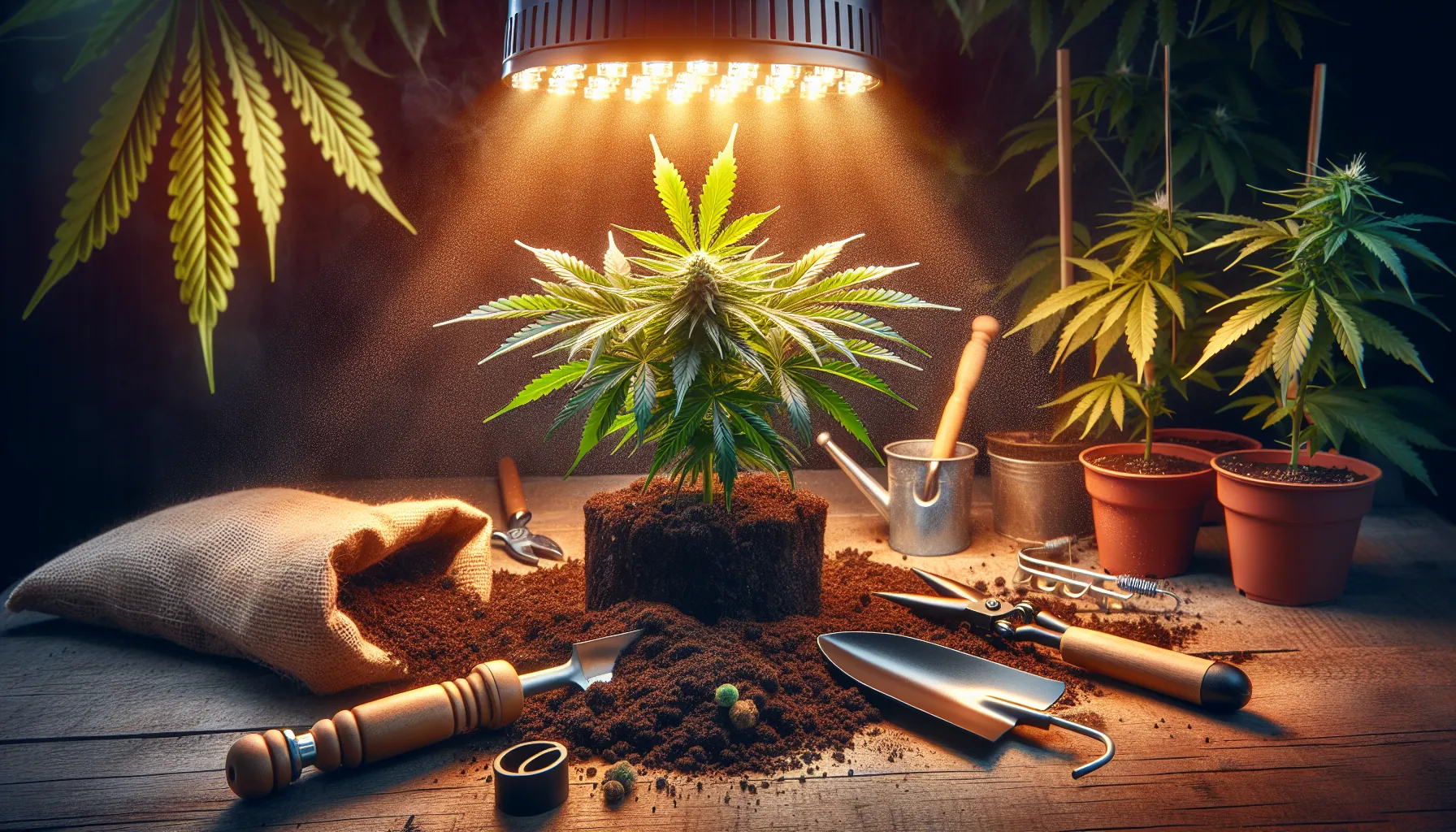Elevate Your Cannabis Cultivation Experience

Are you ready to elevate your cannabis cultivation experience? Outdoor growing presents a natural and cost-effective method to produce top-quality weed. By harnessing sunlight, fresh air, and organic soil, outdoor cultivation yields robust plants with potent buds. Whether you’re a seasoned grower or a novice, unlocking the secrets of outdoor growing can revolutionize your harvest. This guide will explore essential techniques, tips, and tricks for successful outdoor cultivation. From selecting the right strains for your climate to mastering soil preparation and pest management, we’ll cover everything you need to maximize your outdoor harvest. Embrace the great outdoors and discover the satisfaction of cultivating your own top-shelf weed. Let’s embark on this journey together and unlock the full potential of outdoor growing.
Selecting the Ideal Cannabis Strain for Outdoor Growth
When it comes to growing cannabis outdoors, selecting the right strain is crucial for a successful harvest. Factors such as climate considerations and pest and disease resistance play a significant role in determining the ideal strain for outdoor cultivation.
Climate Considerations
The first and foremost consideration when selecting a cannabis strain for outdoor growth is the climate. Cannabis plants thrive in different climatic conditions, and choosing a strain that is well-suited to the local climate can significantly impact the success of the cultivation. For instance, some strains are better suited for warm and sunny climates, while others are more resilient to cooler temperatures and higher humidity levels. Understanding the specific climate of the cultivation site is essential for choosing a strain that can thrive and produce high-quality yields.
In warmer climates, strains such as Sour Diesel and OG Kush are popular choices due to their ability to withstand higher temperatures and abundant sunlight. These strains are known for their resilience to heat and their capacity to produce robust buds in such conditions. On the other hand, for regions with cooler temperatures and shorter growing seasons, strains like Northern Lights and Blueberry are preferred for their ability to thrive in such environments. By selecting a strain that aligns with the local climate, growers can optimize their chances of a successful outdoor harvest.
Pest and Disease Resistance
Another critical factor to consider when selecting an outdoor cannabis strain is its resistance to pests and diseases. Outdoor cultivation exposes plants to a range of potential threats, including insects, mold, and mildew. Choosing a strain with natural resistance to these threats can help minimize the risk of crop loss and reduce the need for extensive pest control measures.
Strains such as White Widow and Blue Dream are known for their robust resistance to common pests and diseases, making them suitable choices for outdoor cultivation. These strains exhibit natural defenses against pests and are less susceptible to mold and mildew, making them easier to manage in an outdoor setting. By prioritizing pest and disease resistance when selecting a strain, growers can mitigate potential risks and ensure a healthier and more resilient crop.
Selecting the ideal cannabis strain for outdoor growth requires careful consideration of climate and pest resistance. By understanding the specific climate of the cultivation site and choosing a strain that aligns with it, growers can optimize their chances of a successful harvest. Additionally, prioritizing pest and disease resistance can help minimize risks and ensure a healthier crop. With the right strain selected,
outdoor cannabis cultivation can be a rewarding and fruitful endeavor.
Preparing the Outdoor Growing Space
When it comes to outdoor gardening, the first step is to prepare the growing space. This involves careful consideration of site selection, soil preparation, as well as understanding the sunlight and water requirements for the plants.
Site Selection
Selecting the right site for your outdoor garden is crucial for the success of your plants. Look for an area that receives ample sunlight, preferably 6-8 hours a day, and has good air circulation. Avoid low-lying areas that are prone to waterlogging, as this can lead to root rot and other issues. Additionally, consider the proximity to trees or large shrubs that may compete with your plants for water and nutrients.
Soil Preparation
Once you have identified the site, it’s time to prepare the soil. Start by testing the soil to understand its composition and pH levels. This will help you determine if any amendments are needed to improve the soil quality. Adding organic matter such as compost or well-rotted manure can help improve soil structure, drainage, and fertility. It’s important to till the soil to a suitable depth to ensure that the roots can penetrate easily and access nutrients.
Sunlight and Water Requirements
Understanding the sunlight and water requirements of the plants you intend to grow is essential for their overall health and productivity. Different plants have varying needs when it comes to sunlight exposure. Some thrive in full sun, while others prefer partial shade. Take note of the sunlight patterns in your selected growing space throughout the day to ensure that it aligns with the needs of your chosen plants.
Water is another critical factor in plant growth. Consider the natural water availability in your chosen site and the specific watering needs of the plants. Some plants require consistently moist soil, while others prefer drier conditions. Installing a drip irrigation system or soaker hoses can help ensure efficient water delivery to your plants while minimizing water waste.
Preparing the outdoor growing space involves thoughtful site selection, thorough soil preparation, and a clear understanding of sunlight and water requirements. By paying attention to these key elements, you can create an optimal environment for your plants to thrive and flourish.
Caring for Outdoor Cannabis Plants
Watering and Nutrient Management
Proper watering and nutrient management are crucial for ensuring healthy growth and high-quality yields. Cannabis plants require a consistent supply of water, especially during the hot summer months. However, overwatering can lead to root rot and other issues, so it’s essential to strike the right balance.
To determine when to water your outdoor cannabis plants, it’s important to monitor the soil moisture levels. A simple way to do this is by inserting your finger into the soil up to the first knuckle. If the soil feels dry at this depth, it’s time to water the plants. Additionally, using a moisture meter can provide more accurate readings and help prevent overwatering.
In terms of nutrient management, outdoor cannabis plants benefit from a well-balanced fertilizer regimen. During the vegetative stage, a fertilizer high in nitrogen can promote healthy foliage growth. As the plants transition into the flowering stage, a fertilizer with higher levels of phosphorus and potassium is ideal for supporting robust bud development.
Pruning and Training Techniques
Pruning and training techniques play a significant role in maximizing the potential of outdoor cannabis plants. Pruning involves the strategic removal of certain parts of the plant, such as fan leaves and lower branches, to improve airflow and light penetration. This practice not only helps prevent moisture-related issues and pest infestations but also encourages the plants to focus their energy on producing larger, more potent buds.
When it comes to training techniques, low-stress training (LST) and high-stress training (HST) methods can be employed to shape the plants and optimize their canopy. LST involves gently bending and securing the stems to encourage lateral growth and create a more even canopy. On the other hand, HST techniques, such as topping and super cropping, involve more drastic manipulation of the plant’s structure to achieve similar goals.
It’s important to note that both pruning and training should be carried out with care and precision to avoid causing undue stress to the plants. Additionally, timing is crucial, and these techniques are best implemented during the early vegetative stage when the plants are more resilient and responsive to manipulation.
Proper watering and nutrient management, along with effective pruning and training techniques, are essential components of caring for outdoor cannabis plants. By mastering these aspects of cultivation, growers can nurture robust, healthy plants that yield bountiful, high-quality buds. With the right knowledge and techniques, cultivating outdoor cannabis can be a rewarding and fulfilling experience.
Harvesting and Processing Outdoor Cannabis
Determining the Optimal Harvest Time
When it comes to harvesting outdoor cannabis, determining the optimal harvest time is crucial for ensuring the best possible quality and potency. The ideal time to harvest cannabis is when the trichomes, the tiny resin glands on the buds, have reached their highest level of cannabinoid production. To determine this, many growers use a jeweler’s loupe or a handheld microscope to closely examine the trichomes. At the peak of their development, the trichomes will appear milky white or cloudy, indicating that the THC levels are at their highest. Additionally, some growers also look for amber-colored trichomes, which signify a higher CBN content and a more sedative effect. By carefully monitoring the trichomes, growers can ensure that they harvest their outdoor cannabis at the perfect time to achieve the desired potency and effects.
Drying and Curing Methods
After the cannabis plants have been harvested, the next crucial step is to dry and cure the buds properly. Drying the buds slowly in a dark, well-ventilated space is essential for preserving their flavor, potency, and overall quality. The ideal drying environment maintains a temperature of around 60-70°F with a humidity level of 45-55%. Hanging the branches upside down allows for proper air circulation and prevents mold or mildew from developing. Once the buds are dry to the touch and the smaller stems snap instead of bend, they are ready for the curing process.
Curing the buds involves storing them in airtight containers, such as glass jars, and burping them daily to release excess moisture and maintain proper humidity levels. This process allows the flavors to develop and mature while also enhancing the smoothness of the smoke. Properly cured cannabis will have a more desirable aroma, smoother smoke, and a more potent high. Many experienced cannabis enthusiasts believe that the curing process is just as important as the growing and harvesting stages, as it can significantly impact the overall quality and experience of the final product.
The process of harvesting and processing outdoor cannabis requires careful attention to detail and a deep understanding of the plant’s lifecycle. By determining the optimal harvest time and employing proper drying and curing methods, growers can ensure that their outdoor cannabis yields the highest quality buds with the most desirable effects. This dedication to quality and craftsmanship is what sets apart exceptional cannabis from the rest, and it is a testament to the artistry and skill of those who cultivate this extraordinary plant.
Conclusion
Outdoor cannabis cultivation can be a rewarding and fruitful endeavor, especially when considering the unique challenges posed by sandy soil. The webpage at. JGSeeds Offers valuable insights and expert tips for maximizing growth and yield in such conditions. With a focus on affordable options for finding cheap cannabis seeds and a wide range of CBD-rich hybrid, indica, and sativa seeds, this resource is a valuable asset for individuals interested in outdoor cannabis cultivation. By following the advice and recommendations provided on this webpage, growers can unlock the secrets to successful outdoor cannabis cultivation in sandy soil, ultimately leading to a bountiful harvest. For more detailed information and to explore the wide range of seeds available, visit. JGSeeds .










